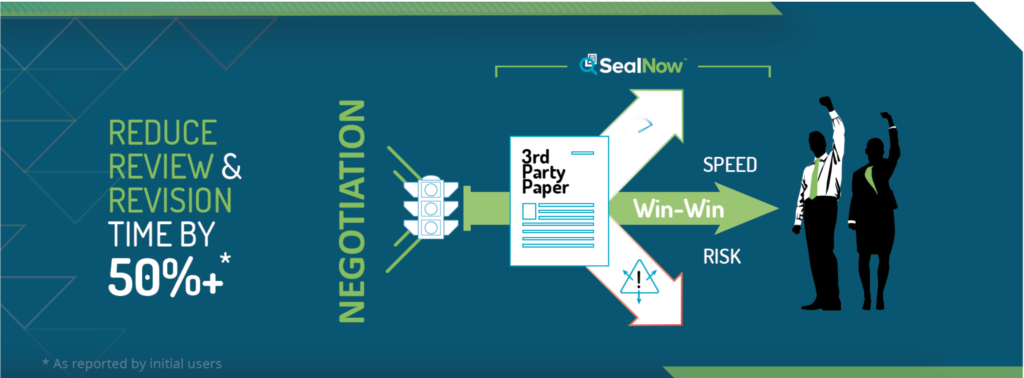
By David Silbert, Director at Seal Software
The contract negotiation process is highly inefficient at scale.
The back-and-forth between parties, often involving multiple resources and subject matter experts, makes contract drafting, negotiation, and execution slow and tedious. Differences in contracts and contracting standards, particularly when working with third-party paper, are fundamentally inefficient and manually intensive.
While various types of software solutions exist, they are poorly suited to the needs of contract teams and legal professionals. Indeed, Accenture recently revealed the average business takes nearly 31 days for in-house counsel to negotiate a standard contract. To solve this problem, Seal Software has brought the power of AI to Seal Now – a plug-in for Microsoft Word – to identify risk, normalize drafting standards, and turn drafts in record time.
Contract negotiation stuck in the past
Historically, contract negotiation involved a labyrinthine web of requestors, approvers, and collaborators. These touch points burned time on process rather than legal analysis. DocuSign, the Agreement Cloud company, recently reported that more than half of companies go through an average of three or four revisions before contracts are finalized. This versioning and modification consumes precious time.
The same report indicated that complex agreements, which account for significant revenue, often take significantly more time to negotiate. The most egregious examples arise when working with third-party paper, which requires extensive manual clausal analysis to ensure alignment with organizational standards.
Unfortunately, poorly adapted contract management and negotiation tools exacerbate these issues. While some CLM solutions and function-specific software – such as source-to-pay suites for procurement – offer respectable functionality for contract authoring and negotiation, they rarely support advanced contract analytics.
Often, those tools rely on an organization’s template to build process efficiencies, but do not alleviate the substantive analysis challenges associated with third-party paper. Moreover, those tools lack contract-specific intelligence or automated risk analysis based on meaning. Thus, inefficiencies persist.

Enhanced contract negotiation
Seal Now brings substantive risk analysis where contract teams live – in Microsoft Word. This is a game-changer. By automating the substantive risk analysis associated with company-specific compliance requirements of individual clauses and concepts, Seal Now allows organizations to triage the risk in third-party paper in seconds, not hours.
Not only does Seal Now triage risk topic-by-topic, it integrates an organization’s pre-approved clause library with fallbacks and guidance into Microsoft Word as well. By bringing AI into Microsoft Word, Seal Now virtually eliminates new software training and improves adoption rates for end users.
When a user opens a draft contract in Microsoft Word, they can submit the document for analysis in Seal. The draft contract then is evaluated clause-by-clause by conceptual models the end user has identified and enabled in Seal. In turn, these models highlight both the presence and absence of critical language and contract requirements of the draft contract in Microsoft Word itself.
Simplified risk mitigation
By leveraging automated logic, organizations can then set specific risk levels associated with the presence or absence of those critical elements such as termination rights and restrictive covenants. With that logic in place, end users can quickly triage ‘red’ high-risk elements, ‘yellow’ medium-risk elements, and ‘green’ low-risk elements, clicking through the identified issues and viewing them directly in the document in Microsoft Word.
Once the presence or absence of critical language has been identified, Seal Now can further develop risk ratings based on detailed information within those clauses. For example, knowing that the agreement contains a fixed-dollar cap on damages may have moderate risk for an organization. But if that company determines that caps of $1 million or less are not risky, then Seal Now can isolate that value and report caps within that zone as ‘low risk’ and above that zone as ‘high risk’.
Further, if Seal Now identifies an unacceptable risk in a certain clause, the end user can then swap out non-compliant or unacceptable language with pre-approved language using the integrated clause library in Microsoft Word. That clause library contains not only an organization’s primary favored language, but guidance and fallback clauses to leverage in negotiation. Because everything lives in Microsoft Word, end user changes are inserted into the document immediately and show as a standard redline to accelerate turning the draft.
Finally, Seal Now facilitates reporting on risks and opportunities in third-party agreements. Upon submission, Seal Now generates an email containing high-level reporting for key personnel and an accompanying PDF report detailing the topic, subtopic, and explanation of risk by type. End users can also perform side-by-side comparisons of any agreements – such as new versions of the same contract – in the corresponding web-based interface.
A recent white paper explains that the time for AI in contract management solutions has come. Seal Software has led the field in converting contracts from pages and pages of legalese into actionable data and intelligence. Seal Now brings these AI capabilities directly into the contract negotiation process. Readily usable and innovative, Seal Now allows end users to negotiate better and faster, improving time to execution while normalizing contract language and minimizing risk.
About the author:
David Silbert is a Director – Practice Lead at Seal Software where he designs and implements client solutions. Prior to Seal, David served as a Director with Apogee Legal and practiced law at Norton Rose Fulbright and King & Spalding focusing on private equity and capital markets transactions as well as complex commercial litigation for clients in the financial services, energy, and real estate industries. Before attending law school at Northwestern University, he worked for the U.S. Department of Justice in the Legal Policy Section of the Antitrust Division studying the interplay between intellectual property and antitrust law.

[ Artificial Lawyer is proud to bring you this sponsored article by Seal Software. ]